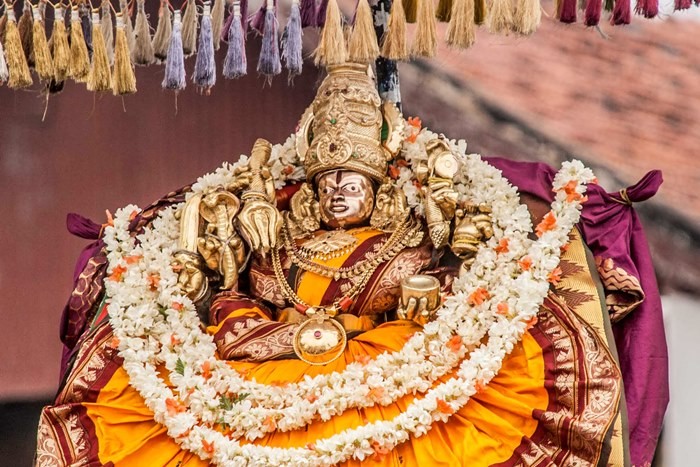Mysore, the city of Tipu Sultan and famous for Mysore Kingdom (which continues to exist even today), is most famous for its 10 day long festivities and celebrations during Dasara. The Mysore palace will be decked for the occasion and the entire city takes a festive look during this period. The city will be thronged by tourists from world over, especially to watch the famous Jambu Savari.
While we all have heard about Mysore Dasara, there is yet another important aspect of these celebrations which rarely gets noticed like the Mysore Palace celebrations. It is temple of Chamundeshwari in Chamundi Hills within Mysore city. This temple is part of Astadasa Shakti Peethams and is said to be very influential Goddess, where the Sati’s “hair “ is said to have fallen, after the Daksha Yagna.
Dasara festivities are very prominent in this temple and are a prominent pilgrimage centre for many in this part of the country.

About the temple
Mysore was ruled by the demon-king Mahishasura, he was a buffalo-headed monster. For this reason, came the name of this place – Mahishuru, the town of demon Mahisha. Hearing to the prayers of Gods and Goddess to save them from the monster, Goddess Parvathi, (consort of Lord Siva), took birth as Chamundeshwari and killed the monster. After killing the demon, the Goddess resided atop the Chamundi Hills, where she is worshiped with reverence and devotion. The goddess is also called Mahishasura Mardini meaning She who slew Mahishasura.
The main deity at the temple atop Chamundi Hill is not that of Mahishasuramardhini. She is Chamundi, but not Mahishasuramardhini
The hill had a temple of Mahabaleshwara and it was called Mahabaladri or Marbala Teertha. A small temple next to that was that of Chamundi. It gradually gained importance and eventually the name Mahabaladri was forgotten and Chamundi Betta became popular. There is also literary evidence that the deity was that of Vasanthika Devi and Shanthodeyar, ruler of Karugahalli renamed Padmavathi Vasanthika Devi as Chamundeshwari and constructed the temple. Till late 17th century, Chamundeshwari was offered animal sacrifice as part of the tribal rituals and was fondly called as Chamayi. After the arrival of Agamikas from Tamil Nadu during the early part of 18th century, Chamayi became the Mahishasuramardhini Chamundeshwari and got worshipped in the formal Vedic ways.
Must read : Navratri : 9 Manifestations of Goddess Durga
Legends
According to the local legend how Chamundi came to settle atop the hill is that the king of Ujjain, Bijjalaraya had seven daughters. The eldest one was called Urimasani, (one who burns), also Piriyapattanadamma. The youngest one was Chamundi. The sisters were all fighters and once they fought so fiercely that they left home in the north and dispersed to various places in the south. All six of them settled down, but Chamundi could not find a suitable place. When she happened to see Mahishamandala, which was very prosperous, she decided to stay there. However the guards questioned her and she burnt all of them with a sheer glance. Scared, the guards approached their king Mahishasura. The king rushed to the spot to see who had the guts to scare off his guards. The minute he spotted Chamundi, he fell in love with her and wanted to marry her. She rejected his love, leading to a fierce war. However, from every drop of blood of Mahishasura that fell on the ground a crore demon replicas took birth and started fighting. Chamundi too fought endlessly. The demon then hid inside a bison. Chamundi searched for him everywhere. Sweat covered her brows. She wiped it with her hand and shook it on the ground. From the sweat drop a female form took birth and said, “I am your younger sister Urimari. I will spread my tongue all over. You fight and kill him, I will drink his blood.” Encouraged by this, Chamundi intensified her search and stared at the bison. Her seething eyes caused the bison to split into two and the demon hiding inside came out. Chamundi seared his head and Urimari drank all the blood. It was the end of the demon.”
Chamundi was thankful to her sister Urimari and asked her to reside at the foothills of Uttanahalli village. She is also called Jwalamukhi . Ammanavaru and those who worship Chamundi also offer prayers to Jwalamukhi.

According a folklore Folk passion
The most famous folk epic in Kannada is the Nanjunda-Chamundi love story. Nanjunda, being the Shiva or Srikanteshwara residing at Nanjangud, is said to be travelling the three lokas and does not come home at all. Chamundi sends her sister Urimari to fetch him. When she arrives to deliver the message, Nanjunda is charmed by her and she too falls in love with him. The epic poem narrates what happens between the three of them, which reads like a classic.
History
The Chamundi temple has always been patronised by the rulers of Mysore. In 1659 Dodda Devaraja Wodeyar built 1,000 steps and big Nandi, Lord Shiva’s Bull. This gigantic Nandi is likely one of the largest within India, 16 ft. (4.8 meters) in the front and 25 ft. (7.5 meters) in length. The magnificent pendent bells around its neckline are exquisite. Nandi as well as the temple beside it can be found at the 700th step of the Chamundi Hill.
Krishnaraja Wodeyar III repaired the holy place in 1827 and built the current attractive forty-meter and seven storied Gopura (tower at the doorway) with gold finials, and set up statues of his and his 3 queens. In 1827, Krishnaraja Wodeyar III made arrangements for festivals and processions and gifted Simhavahana in 1843.
Must read: Navratri Special : Ashtadasa Shakthi Peetham – Shankari Devi, Sri Lanka

Other Temples
There are two other temples dedicated near to Chamundi temple, Lakshmi Narayana Swamy and Mahabaleswara temple. Sri Mahabaleswara temple – devoted to Lord Shiva in the shape of Linga, is a oldest temple at the hill. It was built prior to the beginning of the Hoysala rule. Epigraphical evidences point to this area as Mabhala or Mabbala theertha and states that Hoysala King Vishnuvardhana has given donations to the temple in 1128 A.D.
The Mahishasura Statue – built in 1659 by Dodda Devaraja Wodeyar and Rajendra Vilas palace – was once a popular hotel earlier are few other attractions on the Chamundi hill.
A panoramic view of the city is viewed from the top of the Chamundi hills. Among other landmarks, you are able to see the race course, the Lalitha Mahal palace, Mysore Palace, Karanji and Kukkarahalli lakes. At dusk, the view of the city is very beautiful, and on Sunday evenings and during the Dasara festival, the illuminated Mysore Palace glitters resembling gold.
Must Read :Navratri Special : Ashtadasa Shakthi Peetham – Puruhutika Devi, Pithapuram









